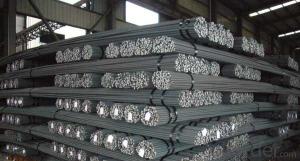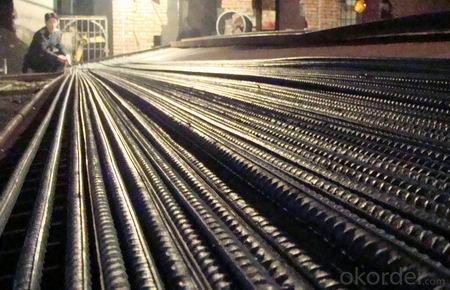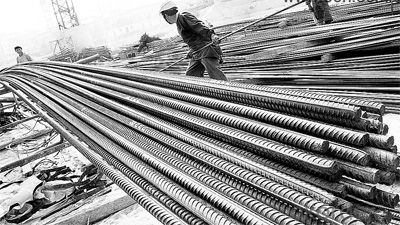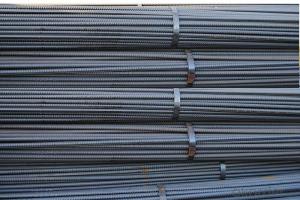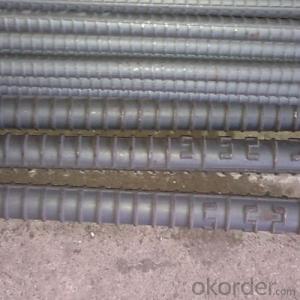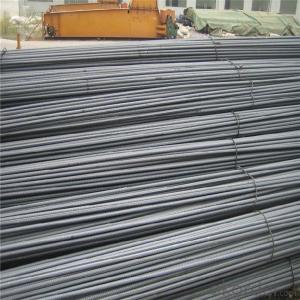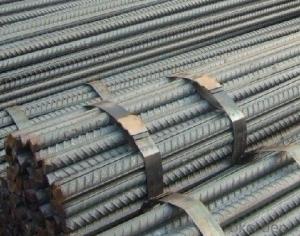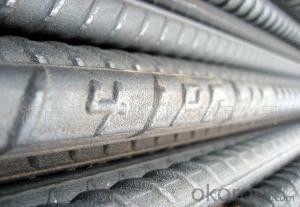50mm*15.42kg/m Deformed steel bar for construction
- Loading Port:
- Tianjin
- Payment Terms:
- TT or LC
- Min Order Qty:
- 25 m.t.
- Supply Capability:
- 100000 m.t./month
OKorder Service Pledge
OKorder Financial Service
You Might Also Like
Product Description:
OKorder is offering 50mm*15.42kg/m deformed steel bar for construction at great prices with worldwide shipping. Our supplier is a world-class manufacturer of steel, with our products utilized the world over. OKorder annually supplies products to European, North American and Asian markets. We provide quotations within 24 hours of receiving an inquiry and guarantee competitive prices.
Product Applications:
50mm*15.42kg/m Deformed steel bar are ideal for structural applications and are widely used in the construction of buildings and bridges, and the manufacturing, petrochemical, and transportation industries.
Product Advantages:
OKorder's Deformed steel bar are durable, strong, and resist corrosion.
Main Product Features:
· Premium quality
· Prompt delivery & seaworthy packing (30 days after receiving deposit)
· Corrosion resistance
· Can be recycled and reused
· Mill test certification
· Professional Service
· Competitive pricing
Product Specifications:
1.Detailed Product Description:
1.High Quality and the best service ;
2..Cheapest Price ;
3.many lines for making ;
4.verious size of Product.
2.Specifications:
Deformed bars/reinforced bars:
1.Material:GB--HRB400/HRB500 ; BS4449--460B/500B;
ASTM A615-Gr40/60 ; AS4671--500N/500E;
JISG3112--SD400 ; DIN488-1--BST500S;
KS-SD390.
2.Standard.:ASTM/JIS/DIN/BS/GB/KS.
3.Diameter:6-50mm.
The Specification of Deformed Steel Bars
| THEORETICAL WEIGHT INDEX | ||
| SIZE(mm) | CUT AREA(cm2) | THEORETICAL WEIGHT(kg/m) |
| 8 | 0.503 | 0.395 |
| 9 | 0.636 | 0.5 |
| 10 | 0.79 | 0.62 |
| 12 | 1.13 | 0.89 |
| 14 | 1.54 | 1.21 |
| 16 | 2.01 | 1.58 |
| 18 | 2.55 | 2 |
| 20 | 3.14 | 2.47 |
| 22 | 3.8 | 2.98 |
| 25 | 4.91 | 3.85 |
| 28 | 6.16 | 4.83 |
| 32 | 8.04 | 6.31 |
| Grade | Technical data of the original chemical composition(%) | ||||||||
| C | Mn | Si | S | P | B | ||||
| HRB335 | ≤ 0.25 | ≤ 1.60 | ≤ 0.80 | ≤ 0.045 | ≤ 0.045 | >0.0008 | |||
| Physics capability | |||||||||
| Yield Strength(N/cm 2 ) | Tensile Strength(N/cm 2 ) | Elongation (%) | |||||||
| ≥ 335 | ≥ 490 | ≥ 16 | |||||||
| Grade | Technical data of the original chemical composition (%) | |||||
| C | Mn | Si | S | P | V | |
| HRB400 | ≤0.25 | ≤1.60 | ≤ 0.80 | ≤ 0.045 | ≤ 0.045 | 0.04-0.12 |
| Physics capability | ||||||
| Yield Strength ( N/cm 2 ) | Tensile Strength ( N/cm 2 ) | Elongation (%) | ||||
| ≥ 400 | ≥570 | ≥ 14 | ||||
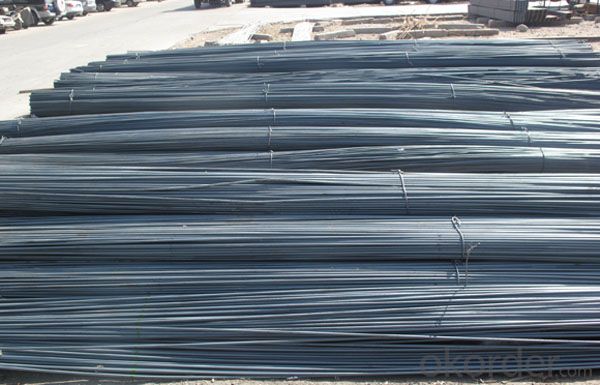

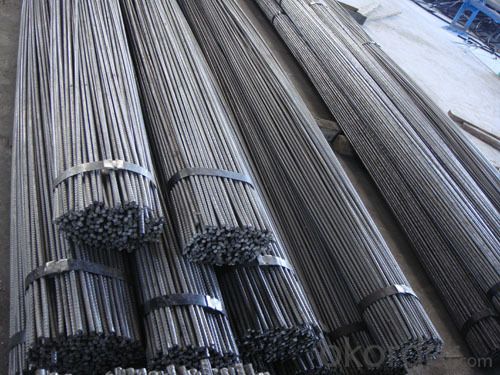
FAQ:
Q1: How do we guarantee the quality of our products?
A1: We have established an advanced quality management system which conducts strict quality tests at every step, from raw materials to the final product. At the same time, we provide extensive follow-up service assurances as required.
Q2: Can stainless steel rust?
A2: Stainless does not "rust" as you think of regular steel rusting with a red oxide on the surface that flakes off. If you see red rust it is probably due to some iron particles that have contaminated the surface of the stainless steel and it is these iron particles that are rusting. Look at the source of the rusting and see if you can remove it from the surface.
- Q: How are steel rebars installed in construction projects?
- Steel rebars play a vital role in reinforced concrete structures in construction projects. The installation process of these rebars encompasses several steps. To begin with, the construction plans and specifications are thoroughly examined to determine the required size, length, and placement of the rebars. This information is crucial to guarantee that the rebars provide the necessary strength and support to the structure. Subsequently, the rebars are cut and shaped according to the specifications. This is typically accomplished using specialized tools like rebar cutters and benders. The rebars are generally supplied in lengthy pieces and are cut to the desired size on-site. Once the rebars are prepared, they are positioned and firmly secured in the formwork or molds that will shape the concrete. This is achieved by placing the rebars in the desired locations and using wire or rebar ties to hold them in place. The ties are typically twisted around the rebars using pliers or a similar tool. This ensures that the rebars maintain their correct positions during the pouring and curing of the concrete. During the pouring phase of the concrete, the rebars are meticulously positioned to ensure even distribution and adequate spacing. This is crucial for providing structural integrity and preventing the formation of weak spots in the concrete. After the concrete is poured, it is left to cure and harden. During this period, the rebars become embedded within the concrete, establishing a strong bond. This bond creates a reinforced concrete structure capable of withstanding various loads and forces. To summarize, the process of installing steel rebars in construction projects involves cutting and shaping the rebars, accurately positioning them within the formwork, and securing them in place using ties. This process is critical for creating durable and robust reinforced concrete structures.
- Q: How do steel rebars affect the overall weight of a construction project?
- Steel rebars can have a significant impact on the overall weight of a construction project. Rebars are typically used to reinforce concrete structures, such as beams, columns, and foundations, to enhance their strength and durability. As steel rebars are made of high-strength steel, they add substantial weight to the project. The weight of steel rebars can affect various aspects of the construction project. Firstly, the total weight of the rebars needs to be considered during the design phase to ensure that the structure can support the additional load. This is particularly important when constructing high-rise buildings or structures that require heavy reinforcement. Additionally, the weight of steel rebars can impact transportation and logistics. As rebars are generally delivered to the construction site in large quantities, their weight can affect the choice of transportation methods, such as trucks or cranes, and may require special permits or equipment. The weight of rebars also adds to the cost of transportation. Moreover, the overall weight of the construction project affects the foundation requirements. The higher the weight of a structure, the stronger the foundation needs to be to support and distribute the load adequately. This may result in the need for deeper or wider foundations, which can increase costs and construction time. Lastly, the weight of steel rebars can impact the overall sustainability of a construction project. Since the production of steel involves significant energy consumption and emissions, the increased weight of rebars can contribute to a higher carbon footprint. Therefore, it is essential for construction projects to find a balance between reinforcement needs and environmental considerations. In conclusion, steel rebars have a tangible impact on the overall weight of a construction project. Their weight affects the design, transportation, foundation requirements, and sustainability of the project. It is crucial for architects, engineers, and project managers to carefully consider the weight of steel rebars to ensure the structural integrity and efficiency of the construction project.
- Q: What are the guidelines for storing steel rebars on a construction site?
- When it comes to storing steel rebars on a construction site, there are several guidelines that should be followed to ensure safety and maintain the quality of the rebars. Here are some key guidelines: 1. Location: Select a designated area on the construction site that is flat, clean, and well-drained for storing the rebars. Avoid areas prone to flooding or excessive moisture. 2. Elevation: Keep the rebars off the ground by using wooden or concrete blocks to prevent direct contact with soil or water. This helps prevent rusting and corrosion. 3. Stacking: Stack the rebars in a stable manner, ensuring that they are aligned vertically and horizontally to maintain their shape and prevent any bending or warping. Use spacers or crates between layers to maintain proper spacing and prevent entanglement. 4. Protection from elements: Cover the rebars with a waterproof tarp or plastic sheet to protect them from rain, snow, or excessive sunlight. This helps prevent rusting and degradation of the rebars. 5. Separation: Store different sizes and types of rebars separately to avoid mixing or confusion during construction. Clearly label and mark each stack to identify the type, size, and grade of the rebars. 6. Accessibility: Ensure easy access to the rebars for construction workers by organizing them in a logical manner. Place smaller rebars on top for easy retrieval and avoid storing heavy rebars on top of lighter ones to prevent damage. 7. Safety precautions: Maintain a safe distance between the rebars and any heavy machinery or equipment to minimize the risk of accidents. Secure the rebars properly to prevent them from falling or causing injury. 8. Regular inspection: Regularly inspect the rebars for any signs of damage, rust, or corrosion. Replace or repair any damaged or compromised rebars to avoid compromising the structural integrity of the construction project. By adhering to these guidelines, construction sites can ensure the proper storage of steel rebars, promoting safety, efficiency, and the longevity of the rebars.
- Q: High strength thread steel hrb400e 32 in diameter, is it special steel?
- Hrb400e diameter 32 of the rebar is not special steel, it is seismic steel.
- Q: Can steel rebars be used in retaining walls?
- Yes, steel rebars can be used in retaining walls. Steel rebars, also known as reinforcing bars, are commonly used in retaining walls to provide additional strength and reinforcement. The rebars are typically embedded within the concrete or masonry structure of the retaining wall, helping to increase its structural integrity and resistance to forces such as soil pressure. The use of steel rebars in retaining walls helps to prevent cracking, shifting, or collapsing of the wall, making it a reliable and durable solution for retaining soil and preventing erosion.
- Q: What are the common problems associated with steel rebars in construction?
- There are several common problems associated with steel rebars in construction. One of the main issues is corrosion. Steel rebars are susceptible to rusting when exposed to moisture and oxygen, especially in humid or coastal environments. This can compromise the integrity of the rebars and weaken the overall structure. Another problem is improper installation. If rebars are not positioned correctly or are not adequately secured, they may not provide the necessary reinforcement and support. This can lead to structural failures and safety hazards. Additionally, the size and spacing of rebars can be a concern. If the rebars are too small or spaced too far apart, they may not effectively distribute loads or resist bending and cracking. On the other hand, if the rebars are too large or placed too close together, it can increase construction costs and make the concrete mix difficult to work with. Another challenge is the potential for poor bonding between the rebar and the concrete. If there is inadequate contact or bonding between the two materials, it can compromise the structural integrity and reduce the load-bearing capacity of the reinforced concrete. Lastly, the quality of the steel rebars themselves can be an issue. Low-quality or substandard rebars may have defects, such as impurities or inconsistencies in their composition, which can weaken the reinforcement and compromise the overall strength of the structure. To mitigate these problems, it is important to use high-quality rebars, follow proper installation techniques, and ensure proper maintenance and protection against corrosion. Regular inspections and testing can also help identify any issues and ensure the longevity and safety of the reinforced concrete structure.
- Q: Can steel rebars be used in structures with high resistance to fire?
- Yes, steel rebars can be used in structures with high resistance to fire. Steel has a high melting point and retains its strength even at high temperatures, making it suitable for use in fire-resistant structures. Additionally, steel rebars can be coated with fire-resistant materials such as epoxy or intumescent coatings to further enhance their fire resistance. These coatings create a protective layer that prevents the steel from reaching its critical temperature and losing its structural integrity during a fire. Therefore, steel rebars are commonly used in various fire-resistant structures such as high-rise buildings, bridges, and industrial facilities where fire safety is a critical consideration.
- Q: How do steel rebars affect the overall weight of a structure?
- Steel rebars add to the overall weight of a structure as they are heavy and dense materials. Their incorporation increases the structural integrity and strength of the building, but also contributes to the overall load that the structure must bear.
- Q: What is the cost-effectiveness of using steel rebars?
- The cost-effectiveness of using steel rebars is high due to their durability, strength, and long lifespan, which reduce the need for frequent repairs and replacements. Additionally, steel rebars offer superior resistance to corrosion and fire, making them a reliable and cost-efficient choice for reinforcing structures.
- Q: Can steel rebars be used in railway and metro construction?
- Yes, steel rebars can be used in railway and metro construction. They are commonly used to reinforce the concrete structures in these types of projects, providing strength and durability to the infrastructure.
Send your message to us
50mm*15.42kg/m Deformed steel bar for construction
- Loading Port:
- Tianjin
- Payment Terms:
- TT or LC
- Min Order Qty:
- 25 m.t.
- Supply Capability:
- 100000 m.t./month
OKorder Service Pledge
OKorder Financial Service
Similar products
Hot products
Hot Searches
Related keywords
